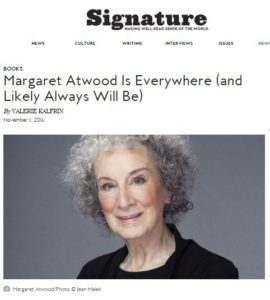
Margaret Atwood / Photo © Jean Malek
By Valerie Kalfrin
Signature Reads, Nov. 11, 2016
Margaret Atwood is fearless. Intelligent and wildly imaginative, but fearless, too, for the way she twists a thought or an image not just into something gruesome but universal and biting and true. She’s a writer who plays with language and characters, multiple meanings and layers, someone not afraid to go there and then tell us where she’s been.
Atwood might chuckle at that description, or more likely, give us a nick with that rapier wit of hers, taking the compliment before skeptically brushing it away. She’s not fond of certain labels and classifications. Through more than forty novels, poetry, and short fiction collections, she writes about women and relationships, but she’s not so much a feminist writer as one who relishes dissecting women’s places and choices. She crafts dystopian futures, like the former United States in The Handmaid’s Tale (1985), where women are subjugated and segregated as breeders, or the genetically modified world of her post-apocalyptic trilogy – Oryx and Crake, The Year of the Flood, and MaddAddam – but scoffs that she writes science fiction. Speculative fiction is the term she prefers, because if we’re not careful, her worlds might actually happen.
“We want wisdom. We want hope. We want to be good. Therefore we sometimes tell ourselves warning stories that deal with the darker side of some of our other wants,” she once wrote. “Literature is an uttering, or outering, of the human imagination. It lets the shadowy forms of thought and feeling – heaven, hell, monsters, angels and all – out into the light, where we can take a good look at them and perhaps come to a better understanding of who we are and what we want, and what the limits to those wants may be.”
The daughter of a forest entomologist for the Canadian government, Atwood spent part of her childhood in the wilderness and grew fascinated with science and the environment as much as myth and fantasy, threads that weave throughout her multiple-award-winning work.
Perception is another frequent theme for her. “There’s the story, then there’s the real story, then there’s the story of how the story came to be told. Then there’s what you leave out of the story. Which is part of the story too,” she writes in 2013’s MaddAddam.
Only she would create The Edible Woman, a literal cake one in her first novel in 1969 and a figurative one in its protagonist, a woman so lost and consumed by her unhappy life that she’s unable to eat. Or The Robber Bride (1993), a woman who became all things to three different women’s beaus, snatching them away while the women themselves struggle to understand whom she really is after all. Or the multilayered deceptions of The Blind Assassin (2000). Atwood’s women often don’t know what to do with the one they desire once they have him, and there’s no underlying sisterhood in her work. But there’s no overarching bitterness, either, although she relishes irony. She’s imagined Penelope, Odysseus’s wife, as no perfect, patient ideal but someone just trying to survive in his absence (2005’s The Penelopiad) and Gertrude, Hamlet’s mother, as the king’s real killer (1994’s Good Bones and Simple Murders).

As seen on Signature Reads
Yet as grim as she can be, she also has the nuance to capture the bittersweet, like the protagonist in 1988’s Cat’s Eye, whose memory of a childhood bully still hangs over her life. “This is what I miss, Cordelia: not something that’s gone, but something that will never happen. Two old women giggling over their tea.”
Atwood turns seventy-seven November 18, and is as exploratory as ever. This year, she’s promoted Hag-Seed, her modern retelling of Shakespeare’s The Tempest, and ventured into a graphic-novel series called Angel Catbird, published by Dark Horse Comics in association with a Canadian conservation charity. Part cat and part owl, her hero mutated thanks to “some spilled genetic Super-Splicer … hence his fur and feathers, and his identity problems,” she’s said.
Next year, Netflix debuts a miniseries of Alias Grace, her 1996 novel based on the true story of Grace Marks, imprisoned in 1843 for murder. Writer-director Sarah Polley (Stories We Tell) adapted the teleplay, directed by Mary Harron (The Notorious Bettie Page).
And there’s more Atwood on the horizon: The Handmaid’s Tale is being adapted as a Hulu series starring Elisabeth Moss and Joseph Fiennes, and MGM Television is developing The Heart Goes Last, her 2015 novel about a couple who live in prison as a social experiment.
No one in our lifetimes will read Scribbler Moon, the book she contributed to the Future Library project in Norway – it won’t be printed until 2114 – but perhaps that’s as it should be.
To write freely, as Atwood noted in The Blind Assassin, you must dare to think that your work exists beyond anyone’s eyes.
“The only way you can write the truth is to assume that what you set down will never be read. Not by any other person, and not even by yourself at some later date,” she wrote. “Otherwise you begin excusing yourself. You must see the writing as emerging like a long scroll of ink from the index finger of your right hand; you must see your left hand erasing it.”
